If you’re in the market for an unusual project, this London taxi certainly fits the bill. You aren’t likely to see very many of these at car shows in the U.S. For sale here on craigslist in Spokane, Washington, with an asking price of $14,995, this 1959 Beardsmore MK7 appears to be in decent shape. I have no idea what availability of restoration parts is, but I would assume if you are going to have to be a bit creative if you take on this project.
The ad states the car has a 4 cylinder gas engine backed by an automatic transmission. The engine bay looks complete, but you can tell it has sat a while. The ad also states “did run and drive” which is promising. This engine looks similar to a Mini 4, so maybe they share some of the same components? That would make a restoration easier as the aftermarket support for Mini’s is fairly strong.
One of the neat things about a unique project like this are the conversation pieces. How many times have you seen a meter or fare table in your average Chevrolet, Ford or Dodge? The “d” in the Fare chart actually indicates Pence. Also note the charge for luggage on the driving platform. What is a driving platform? Check out the next picture.
Here is a shot of the driving platform. If you search the internet for pictures of a Beardsmore taxi, you’ll see luggage strapped down to this platform using a leather strap. It’s a pretty ingenious design which allows larger suitcases to fit in a lower position than having to heave them onto the roof. It also utilizes the normally unused space next to the driver for a practical purpose. One other note, you can see the damage to the front fender. Both of the front fenders appear to be fiberglass. I would assume that they were manufactured this way? The passenger side seems to be the most damaged. It will take a skilled fiberglass worker to repair them and it may be easier to find replacement ones from across the pond?
The rest of the car looks like it’s in decent shape with the front fenders being the only real apparent damage. The red and black color combination is handsome. It may look neat with a bright yellow and black paint job, but the classic red reminds me of the iconic double-decker London buses. If this was my project, I would probably leave it in the current color configuration. What would you do?





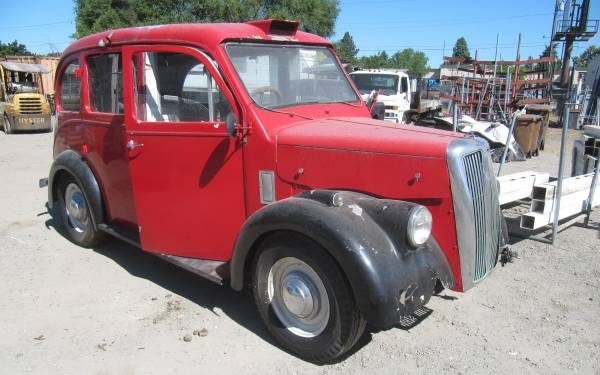
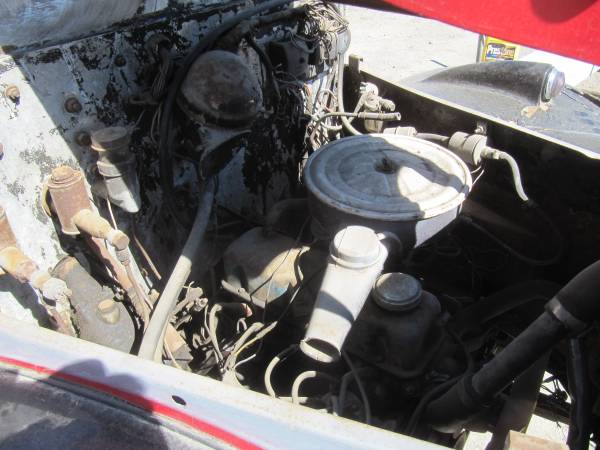
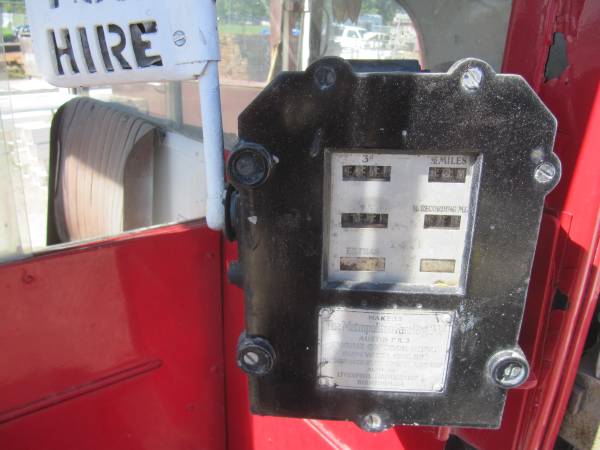

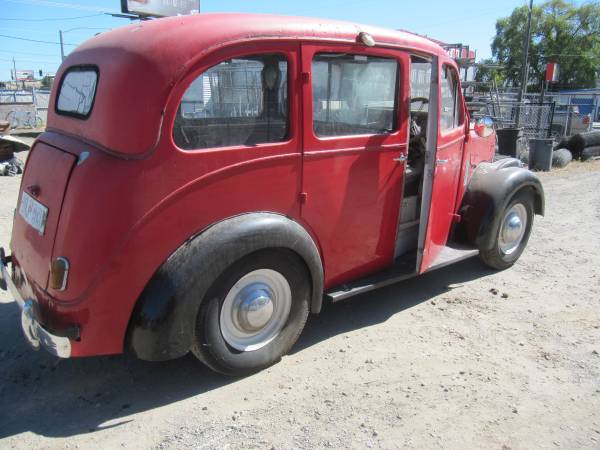
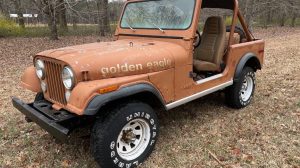
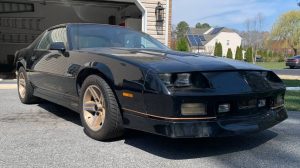
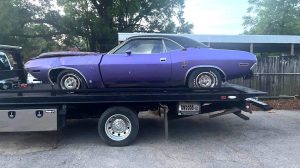



A quick Internet search — though one can’t believe everything one reads on the Internet — says Beardmore taxis were powered by English Ford engines (Consul or Zephyr) displacing 1.5 or 1.7 liters. Certainly a better prospect than a BMC “A” series engine, which this doesn’t appear to be anyway.
I’d say the seller is being extremely optimistic price-wise, as this doesn’t look to me like a wash-and-drive proposition. Mechanical parts shouldn’t be too hard to acquire, but the fenders will take some metalworking skills.
Every London cab I’ve ever seen — in person or photos — was black. The red most likely came along after the cab was retired.
Not my thing (though the list of Brit cars I’d love to own is a long one), but I hope some collector rescues it. The Beardmore company has quite a history, one that extends far, far beyond building taxis. This should be saved.
Do I see a British Taxi Gasser in the future for this car ???
That’s obviously a Datsun engine conversion. These were built with British Ford engines. I owned one years ago in Salem, Oregon. Sold it to a kid in McMuddville. I wonder if this is it??
A short video regarding one of these currently in storage at the London Transport Museum
https://youtu.be/Ee3SK43HRNs
Black. It should be black. Only recently were London cabs allowed to be different colours.
I saw one of these in my hometown in the
late ’60’s. And yes, you are corect, these were always painted black. The car I saw
was all original except for the row of musical horns that were located in,
front of the baggage platform. The man that owned it drove it mostly in local parades or around town doing errands.
Although I believe he told me that his
had a diesel engine mated to a 4 speed
tranny, I could be mistaken as it has been
at least 50 years since I’d seen either him
or the car. Would love to build this as an
Uber car for my sister in law. That would
be absolutely smashing!
Correct name is a Beardmore, not Beardsmore. It’s a model Mk7 Paramount. London regulations allowed a Taxi to be rebuilt after 10 years, then run for another 10 years. After that 20 year period, they were often sold off to small town taxi companies. Most likely the glassfibre front wings [Fiberglass front fenders] replaced the metal ones when it was rebuilt. Beardmore cabs have partial wood framing for the body, the doors are ash wood framed with alloy panels. I would be suspicious of this one when all the photos show the driver’s door open a few inches. The Mk7 was made from 1954 until 1966, and they only made a little over 650 cars during that time. However they did stay busy rebuilding the cars too. Yes, Ford Consul/Zodiac drive trains were used, also available was a Perkins diesel*. You can see from the view of the firewall that this car was a manual gearbox when new, the Girling hydraulic clutch master cylinder is still mounted next to the brake master cylinder!
Spare parts are not too difficult to find, and “The London Cab Company” sends spare parts worldwide. I’ve had 2 Beardmore cabs, one a 3-door, the other a 4-door used in a taxi service over near Oxford.
The theory about why the open luggage platform says the London regulations didn’t allow luggage to be placed in an enclosed luggage area, luggage was either on a fold down rear rack, or in the platform next to the driver. It was hoped that the driver would not forget the luggage if it was visible to him, and placed next to the driver, it was thought to be better protected from the elements.
As for the “D” on the meter, that is for “Dimes”. “P” is for pence/pennies. This is an old currency meter, used before they went decimal in 1966, eliminating the dimes coin.
*In 1962 Studebaker bought 2 Perkins Diesel taxicab engines and put them into a couple of Larks, a 2-door and a 4-door with the taxicab HD chassis, and evaluated how Americans felt about diesel taxicabs, and the feasibility of selling diesel cabs, but they never did go into production. I must say I had the opportunity to drive the 2-door Studebaker-Perkins many years ago, and it was pretty damn slow, very gutless! Here is a photo of the Perkins in the Studebaker lark chassis.
Pre decimal currency in the UK was £ s d (pounds, shillings and pence) The symbol for a pound is in fact an L. £ s d stands for Librae, Solidi, Denarii which is latin,
My Beardmore came with glasfibre front wings from new but yes, the rest of the body was built in the traditional manner of aluminium over wood framing by Windovers . Lights & electrics are Lucas, gauges by Smiths and brakes by Girling. The body may be aluminium but nothing is unobtanium.
The progression, which caused much mirth in the 1960s, was L, s, and d, for pounds, shillings, and pence. The UK converted to decimal currency in February 1971. 12 pennies to the shilling and 20 shillings to the pound. The guinea, used in professional fees, was 21 shillings.